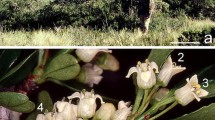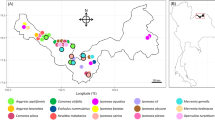Abstract
Interspecific interactions can vary within and among populations and geographic locations. This variation can subsequently influence the evolution and coevolution of species interactions. We investigated population and geographic variation in traits important to pollinating seed-consuming interactions between the senita cactus (Lophocereus schottii) and its obligate pollinating moth (Upiga virescens), both of which are geographically restricted to the Sonoran Desert. Female moths actively pollinate senita flowers and oviposit onto flowers. Their larvae consume developing seeds and fruit of flowers pollinated by females. Traits important to this interaction include fruit set from moth pollination, fruit survivorship, and costs of fruit consumption by larvae. We studied these traits for five populations at two widely separated geographic locations. On average, 37% of flowers set fruit, 22% of flowers produced mature fruit, and larvae consumed 25% of immature fruit pollinated by female senita moths. Senita cactus and senita moth interactions were strongly mutualistic in all populations that we studied. Although one population had statistically lower fruit set and fruit production than the other four, all five populations were qualitatively similar in fruit production, costs, and patterns of fruit survivorship. Hand-pollination experiments suggested that fruit set was resource-limited in all but this one population. Apparent pollen limitation in the one population explains the quantitative differences in fruit set and fruit survivorship among the populations. As predicted by theory and exemplified by the senita mutualism, specialized and/or obligate interactions vary little among populations and geographic locations.
Similar content being viewed by others
Author information
Authors and Affiliations
Additional information
Received: 5 March 1999 / Accepted: 25 June 1999
Rights and permissions
About this article
Cite this article
Holland, J., Fleming, T. Geographic and population variation in pollinating seed-consuming interactions between senita cacti (Lophocereus schottii) and senita moths (Upiga virescens). Oecologia 121, 405–410 (1999). https://doi.org/10.1007/s004420050945
Issue Date:
DOI: https://doi.org/10.1007/s004420050945




